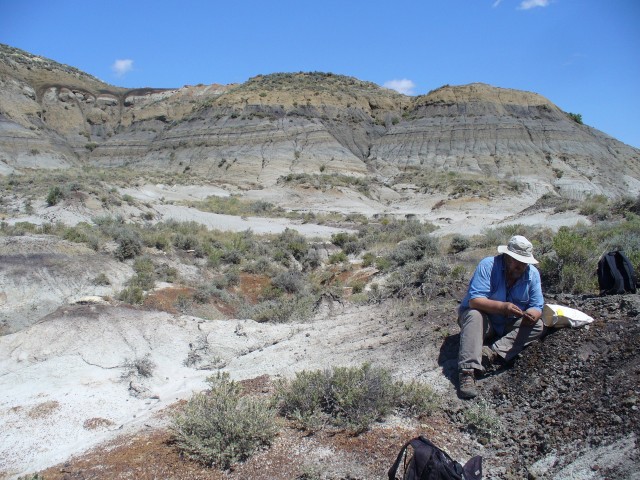
Of all the mass extinction events in Earth’s history, the most familiar is probably the one that wiped out the dinosaurs and ushered in the age of the mammals. Most of us know the story—a hellish meteor impact that dragged about 3 out of every 4 species into extinction.
But the story is more complicated than that. There was also a series of incredibly massive and long-lived volcanic eruptions—they formed the Deccan Traps—around the same time. A second smoking gun, if you will. So which one did in the dinosaurs? Well, that depends on when the bullets were fired.
The debate started with the discovery of a layer of clay present throughout the world, and situated right at the boundary of the Cretaceous and (more recent) Paleocene rocks, marking the point where the fossils suddenly change. In the clay, there was a curiously sharp spike in iridium—an element that is generally rare in Earth’s crust. That suggested an extraterrestrial visitor (of the rocky and violent kind), since some asteroids are rich in elements like iridium.
Later, the Chicxulub Crater just off the Yucatán Peninsula was found to be of about the right age. But attempts to date the crater, the Deccan Traps, and the iridium-rich clay led to conflicting results. Some estimates put the meteor impact several hundred thousand years before the extinction event. Others showed the impact arriving after the extinction.
But puzzled dinosaur lovers need not fret, as a new study using improved dating methods has found that the meteor impact lines up nicely with the extinction after all.
The confusion arose from the error bars for dates this old (66 million years) being too large to reliably work out the details on the scale of a few tens of thousands of years, details that were important to this story. A recent refinement of a method for determining the age of certain types of rock (one based on the decay of potassium into argon) made it possible to more accurately and precisely date the extinction.
The age of the impact that created the Chicxulub Crater was pinned down using tiny blobs of rock that were ejected white-hot from the impact crater, cooled mid-air, and landed (in this case) in Haiti. The age for the extinction came from layers of (local) volcanic ash near the iridium-rich clay at a site in Montana. As confirmation, some of the ash was also dated using the decay of uranium to lead, as well.
The dates for the impact and extinction were essentially identical, within the error bars of about 30,000 years—or as Paul Renne, a UC-Berkeley professor who led the study, explained in a university press release, “We have shown that these events are synchronous to within a gnat’s eyebrow.”
The timeline the study sets out includes drastic climate changes in the million years before the meteor hit. As the Deccan Traps eruptions sputtered to life, their emissions drove several sharp drops in global temperature. After millions of years of a hot climate, these cooler periods were likely rough for many species. It was during this already difficult time that the meteor struck the killing blow.
A more detailed account of the Deccan Traps will be needed to establish this version of events, but this work represents significant progress towards fleshing out the demise of the dinosaurs.
The new dates also shorten up the time between the extinction and the return of vertebrate fossils (including mammals) in the Montana rocks. What had previously been thought to be a 400,000 year hiatus now appears to have been less than 50,000 years. Given that short timeframe, the creatures that show up in these fossils were probably survivors from other regions rather than new species that arose after the extinction cleared the ecological decks—preparing the way for the mammal revolution.
Science, 2013. DOI: 10.1126/science.1230492 (About DOIs).
reader comments
62